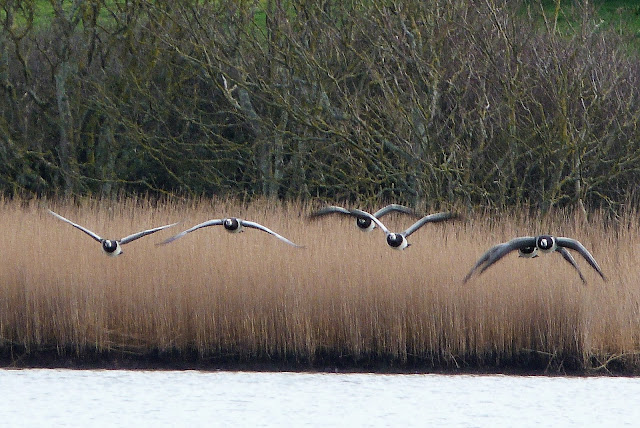Waterfowl...
Brent Geese were seen on three dates (all 'Russian Brants' aka 'Dark-bellied Brent Geese'), with a peak of 53 on the 16th; Canada Geese were present daily with a peak of 180 on the 15th; eleven Barnacle Geese were seen briefly on the 22nd; single Greylag Geese were present on the 1st, 5th and 27th, with the latter bird being in the company of a single Bar-headed Goose (the first since 2015).
 |
Barnacle Geese, Abbotsbury Swannery, February 2021 © Steve Groves |
The herd of around 400 Mute Swans still held the four Whooper Swans (the three wild birds and the resident escape) throughout, along with the single wintering Black Swan.
All the expected ducks were present with peak counts of 15 Shelduck, 80 Shoveler, 5 Gadwall, 16 Wigeon, 310 Mallard, 6 Pintail, 300 Teal, 300 Pochard, 150 Tufted Duck and 20 Red-breasted Merganser.
The four Scaup and the wintering second calendar female Ferruginous Duck were present daily until the 24th but were not seen subsequently.
 |
Scaup, Abbotsbury Swannery, February 2021 © Steve Groves |
 |
Scaup, Abbotsbury Swannery, February 2021 © Steve Groves |
 |
Ferruginous Duck (2nd calendar year female), with Shelduck & Coot, Abbotsbury Swannery, February 2021 © Steve Groves |
 |
Ferruginous Duck (2nd calendar year female) & Shelduck, Abbotsbury Swannery, February 2021 © Steve Groves |
Shorebirds...
At least four Oystercatchers were seen regularly; two Avocets were seen on the 15th, followed by a single on the 26th; Lapwings were present throughout peaking at 700 on the 16th; Golden Plovers were noted on four dates with a peak of 20 on the 15th; and three Grey Plovers were seen on the 16th.
 |
Golden Plovers, Abbotsbury Swannery, February 2021 © Joe Stockwell |
Two Knots were seen on the 10th and 16th; Dunlins were seen regularly between the 8th and 17th, with a peak count of 12 on the 9th; Snipe were seen regularly with a peak count of 20 on the 17th; the over-wintering Common Sandpiper was seen regularly; a Green Sandpiper was seen on the 8th; whilst Redshanks were present throughout, with a peak count of seven on the 16th.
Gulls...
The three regular smaller gull species were all present throughout with peak counts of 250 Black-headed Gulls, 300 Mediterranean Gulls and 1,000 Common Gulls. The three regular larger gull species were also present throughout with peak counts of just three Great Black-backed Gulls, 34 Lesser Black-backed Gulls (all apparently being 'British Lesser Black-backed Gulls') and 200 Herring Gulls. The highlight though was a (second calendar year) Yellow-legged Gull on the 15th.
Other Water Birds...
The three regular rails were present throughout, with a peak count of 220 Coots; Moorhens however were a little harder to connect with, with only single figures actually seen, whilst Water Rails were not seen at all but regularly heard.
Both Little Grebes and Great Crested Grebes were present throughout, with a peak of 13 of the former and at least 21 of the latter. A Great Northern Diver that flew west on the 17th was the first since 2015; whilst Cormorants were present throughout, with at least 20 in the roost nightly.
Up to 33 Cattle Egrets continued to roost nightly and there were also of course daily single figure sightings of Little Egrets and Grey Herons but unusually the only Kingfisher noted was on the 12th.
Raptors...
Single Sparrowhawks were seen on two dates; single Marsh Harriers were seen regularly but with two on the 23rd; whilst single figures of Buzzards were seen virtually daily.
Single Barn Owls were seen on three dates; and at least two Tawny Owls were heard regularly.
Kestrels were present in single figures virtually daily; single Peregrines were seen regularly, with two on the 11th; and a single Merlin was seen on the 26th.
Other Non-Passerines...
A Red-legged Partridge was heard on the 28th; whilst 50 odd Pheasants, Feral Pigeons and Wood Pigeons were present throughout, or at least seen regularly, as were a few pairs each of Stock Dove, Collared Dove, Great Spotted Woodpecker and Green Woodpecker.
Passerines...
All the usual Corvids were seen regularly, if not daily, with a couple hundred each of Jackdaw and Rook; low double figures of Carrion Crow; single figures of Magpie and Raven; and singles of Jay.
Great Tit, Blue Tit, Coal Tit and Long-tailed Tit were all relatively numerous throughout and at least one Firecrest continued to overwinter, along with several Goldcrests, Chiffchaffs and Cetti's Warblers.
The nightly Starling roost increased even more with some 25,000 estimated to be present on the 8th although this had apparently dropped to only a few hundred by the month's end.
Wrens, Robins, Stonechats, Blackbirds and Song Thrushes were both relatively numerous throughout but the only Mistle Thrush was noted the 2nd and the only Redwing on the 22nd.
Skylarks, Meadow Pipits and Pied Wagtails were also relatively numerous throughout; whilst up to two Rock Pipits were seen regularly and a single Grey Wagtail was noted on the 26th.
Dunnocks, House Sparrows, Chaffinches, Greenfinches, Goldfinches and Reed Buntings were all seen in single figures regularly, whilst Linnets peaked at over 20 on the 22nd.
March 2021 sightings to follow shortly.
Steve Groves.
Steve Groves.






